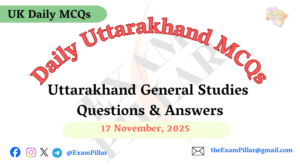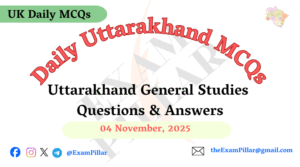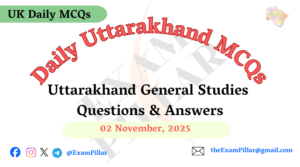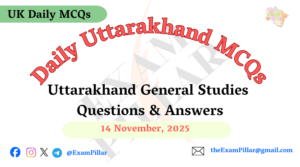The Exam Pillar brings you the Daily MCQs program for examinations conducted by the Uttarakhand Public Service Commission (UKPSC) and the Uttarakhand Subordinate Services Selection Commission (UKSSSC). This program provides candidates with objective study materials tailored to the exam format of the Uttarakhand Public Service Commission and the Uttarakhand Subordinate Services Selection Commission.
Daily UKPSC / UKSSSC MCQs : Uttarakhand
18 November, 2025
| Read This UKPSC / UKSSSC Daily MCQ – (Uttarakhand) in Hindi (हिन्दी) Language |
Q1. What was the method used to construct the burials in Malari village?
(A) Body laid face-down with knees bent
(B) Body placed in a sitting position
(C) Body laid flat in a straight position
(D) Body placed on trees
Click To Show Answer/Hide
Explanation: In Malari village, the burials were made by cutting into the hillside, and the bodies were placed face-down with knees bent. This burial system reflects the religious beliefs and ancient funeral practices of that time.
Q2. What were the colors of the pottery and monal bird figure found in Malari village?
(A) Red and white
(B) Black and grey
(C) Blue and green
(D) Yellow and brown
Click To Show Answer/Hide
Explanation: From Malari village, pottery in black and grey colors and a monal bird figure drawn on a handled pot were discovered. These artifacts showcase ancient art and provide glimpses into the social life of early communities.
Q3. From where were the oldest iron plates in Uttarakhand discovered in Malari village?
(A) Niti Valley
(B) Megalithic (Mahapashan) burials
(C) Ramganga Valley
(D) Hudli site
Click To Show Answer/Hide
Explanation: The oldest iron plates in Uttarakhand were discovered from the Megalithic burials of Malari village. These archaeological findings highlight the technological abilities and early metalworking skills of ancient people in the region.
Q4. Who discovered the burials of Naula–Jainal village?
(A) M. P. Joshi
(B) Yashodhar Mathpal
(C) Yashwant Singh Kathoch
(D) Shiv Prasad Dabral
Click To Show Answer/Hide
Explanation: The burials of Naula–Jainal village, located in the western Ramganga Valley of Almora, were discovered by Yashodhar Mathpal. His findings are important evidence for understanding ancient human life and burial traditions.
Q5. How many types of burials were found from the villages of Sanna and Baseri? Cist burials – made by cutting into hill slopes. Urn burials – where the body was buried inside an earthen pot. This variety reflects the ancient burial customs and socio-cultural perspectives of early communities.
(A) One type
(B) Two types
(C) Three types
(D) Four types
Click To Show Answer/Hide
Explanation: Two types of burials were found in Sanna and Baseri villages:








